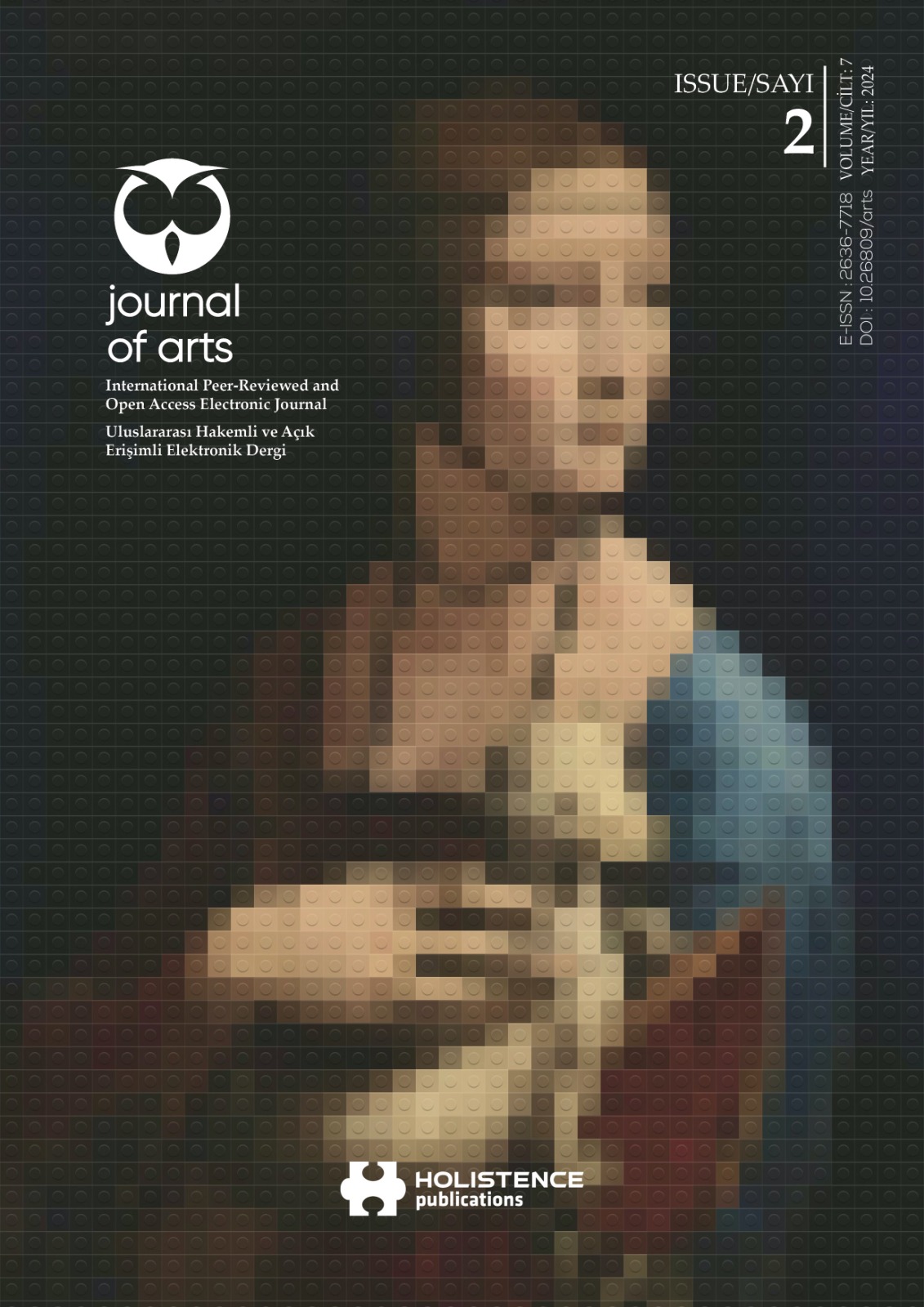Abstract
Jean Baudrillard, who is thought to have great importance at the intersection of architecture and philosophy, is frequently mentioned in his discourses and concepts. His studies, which are related to many disciplines, also interact with each other. There are also discourses based on illusions in a universe where reality is lost and hyperreality is experienced. The concept of trompe-l'œil, which he refers to as illusions, is a technique used especially in the field of painting as a realistic-looking optical illusion. What Baudrillard means by trompe-l'œil produced as real is the creation of a confusion of perception regarding the existence of the non-existent. In this context, it was felt necessary to discuss the architect Jean Nouvel, who is thought to have frequently used the trompe-l'œil technique and who interacted with Baudrillard in the discipline of architecture. The aim of the study is to evaluate trompe-l'œil, an optical illusion technique, and its use in the field of architecture through Nouvel architecture. In addition, what can be done using the trompe-l'œil technique to create the desired perception in architecture is explained with examples. The sample of the study consists of Jean Nouvel's buildings. The structures within the scope of the study were discussed through the texts in which Jean Nouvel described the structures. Because it is necessary to directly obtain the architect's thoughts about the design and to make analysis by obtaining clear information. The examples selected from Nouvel's designs were chosen from those thought to be trompe-l'œil, using natural light and glass surfaces. As a result, natural light and glass surfaces are important in Nouvel's designs. It can be said that the Cartier Foundation structure is a direct application of trompe-l'œil.
References
ADANIR, O. (2004). Baudrillard’ın Simülasyon Kuramı Üzerine Notlar ve Söyleşiler, 2. Baskı, İzmir: Dokuz Eylül Yayınları.
AKÇAY, A. A. (2015). Resimde Gerçeklik ve Aldatma, Trompo I’oeil ve Fotogerçekçilik. Uluslararası Sanat Sempozyumu / “Sanat, Gerçeklik ve Paradoks”, Muğla, ss. 29-39.
BARRETT, T. (2022). Sanat Üretimi – Form ve Anlam. Çev. Ebru Berrin Alpay, İstanbul: Hayalperest Yayınevi.
BAUDRILLARD, J. (2019). Kusursuz Cinayet. Çev. Necmettin Sevil, İstanbul: Ayrıntı Yayınları.
BAUDRILLARD, J. (2017). Simülakrlar ve Simülasyon. Çev. Oğuz Adanır, 11. Baskı, Ankara: Doğu-Batı Yayınları.
BAUDRILLARD, J. (2013). Vérité ou radicalité de l’architecture suivi de y-a-t-il un pacte de l’architecture, Paris: Sens ve Tonka.
BAUDRILLARD, J. (2009). Gösterge Ekonomi Politiği Hakkında Bir Eleştiri, Çev. O. Adanır ve A. Bilgin, Boğaziçi Üniversitesi Yayınevi, İstanbul.
BAUDRILLARD, J. (1977). The Trompe-L’oeil. Documents de Travail et pré-publications, Centro Internazionale di Semiotica e di Linguistica, 62 Series F, Universita di Urbino, Italia.
BAUDRILLARD, J. ve Nouvel, J. (2011). Tekil Nesneler: Mimarlık ve Felsefe, Çev. Aziz Ufuk Kılıç, İstanbul: YEM Yayınları.
BOUMAN, O., & VAN TOORN, R. (1994). Tomorrow can take care of itself: a conversation with Jean Nouvel. In The invisible in architecture, London: Academy Editions, Ernst & Sohn, pp. 312-325.
DEMIRKOL, H. (2010). Jean Nuvel’in Çok Katmanlı Mimarisi Üzerinden Bir Kapalı Bahçe Değerlendirmesi. Art-e Sanat Dergisi, 3(5), 1-16.
EBERT-SCHIFFERER, S. (2002). Trompe l’Oeil: The Underestimated Trick.’ In Deceptions and Illusions. Ed. Sybille Ebert-Schifferer. Washington, DC: National Gallery of Art, pp. 17-39.
IHRINGOVÁ, K. (2021). Trompe lʼoeil and Bullshit—The Problem of the Truth of Realistic Depictions. Estetyka i Krytyka, 63(4), 191-205.
İMARABE. (2024). Instıtut Du Monde Arabe: Architecture. https://www.imarabe.org/en/architecture
İNAN, D. (2008). 2008 Pritzker Mimarlık Ödülü Jean Nouvel’in. Mimarlık Dergisi, 341.
İSMAILOĞLU, S. (2021). Jean Baudrillard’da Mekân Gerçekliği. Karadeniz Teknik Üniversitesi Fen Bilimleri Enstitüsü, Mimarlık Anabilim Dalı, Yayımlanmamış Doktora Tezi, Trabzon.
İSMAILOĞLU, S., & BEŞGEN, A. (2019). Replacing Architecture Over Remake Concept: Simulacra Spaces as Design Reality and Representation. LIVENARCH VI, 46-58.
JEAN NOUVEL. (2024a). Biographie. http://www.jeannouvel.com/jean-nouvel/
JEAN NOUVEL. (2024b). Cartier Foundation for Contemporary Art and Cartier Headquarters. http://www.jeannouvel.com/en/projects/fondation-cartier-2/
JEAN NOUVEL. (2024c). National Museum of Qatar. http://www.jeannouvel.com/en/projects/museenational-du-qatar/
JEAN NOUVEL. (2024d). Louvre Abu Dhabi. http://www.jeannouvel.com/en/projects/louvre-aboudhabi-3/
KAYA, Y. (2021). Sanatta Trompe L’oeil Tartışmaları: William M. Da-Vis’in “Bir Tablo Arkası” ve Andy Warhol’un “Brillo Kutusu” Örneklerİ. The Journal of Academic Social Science, 8(111), 351-367.
LANE, R. J. (2008). Jean Baudrillard. Routledge, London.
LITTLE, S. (2016). …izmler-Sanatı Anlamak, 5. Baskı, İstanbul: YEM Yayın- 121, 34.
MAINE, B. (1991). Late Nineteenth-Century Trompe L’Oeil and Other Performances of the Real. Prospects, 16, 281-295.
MASCOLO, O. (2018). The Hague. Ateliers Jean Nouvel completes the new European Patent Office [online]. https://www.domusweb.it/en/architecture/2018/06/29/the-hague-ateliers-jeannouvel-completes-the-new-european-patent-office.html, [10/02/2024].
NOUVEL, J. (1994). Jean Nouvel 1987-1994, El Croquis, Architectural Magazine, Madrid, 65/66.
NOUVEL, J. (1996). Interview by Yoshio Futagawa, A.D.A. Edita, Tokyo, 66.
OCVIRK, O. G., Stinson, R.E., Wigg, P.R., Bone, R.O., Cayton, D.L. (2013). Sanatın Temelleri Teori ve Uygulama, İzmir: Karakalem Kitabevi Yayınları.
PARK, S. Y. (2022). Characteristics of Simulacra in Elements of Trompe-l’oeil as Seen in Cubist Painting: A Focused Review of Works by Braque. The Journal of Aesthetics and Science of Art, 66, 256-276.
RILEY, T. (1995). “Cartier Foundation for Contemporary Art”. Light construction. The Museum of Modern Art. New York, pp. 54-59.
SOMERVILLE, K. (2020). Trompe l’oeil: The Art of Deception. The Missouri Review, 43(4), 141-159.
SÖNMEZ, M. (2011). Çağdaş Mimarlıkta Cephe/Yüzey Kavramı Tartışmaları. Gazi Üniversitesi Fen Bilimleri Enstitüsü, Mimarlık Anabilim Dalı, Yayımlanmamış Doktora Tezi, Ankara.
SÖZEN, M. ve Tanyeli, U. (2014). Sanat Kavram ve Terimleri Sözlüğü. İstanbul: Remzi Kitabevi.
TRINCAL, A. (2009). Jean Nouvel et ses ateliers. Le Journal de l’École de Paris du management, (4), 39-44.
WADE, N. J., & Hughes, P. (1999). Fooling the eyes: trompe l’oeil and reverse perspective. Perception, 28(9), 1115-1119.
YILMAZ, S. (2022). Trompe l’oeil Tekniği ile Doğa Estetiğine Öykünen Seramik Ağaçlar. Sanat Tarihi Dergisi, 31(1), 1-21

This work is licensed under a Creative Commons Attribution 4.0 International License.
Copyright (c) 2024 Holistence Publications


